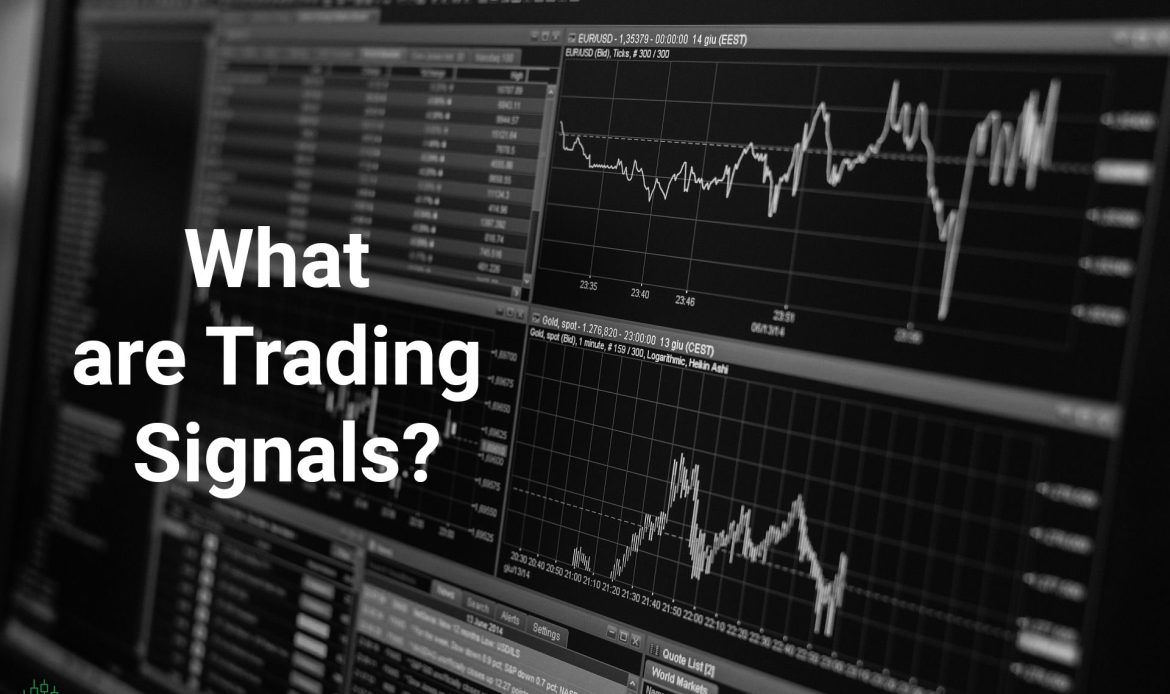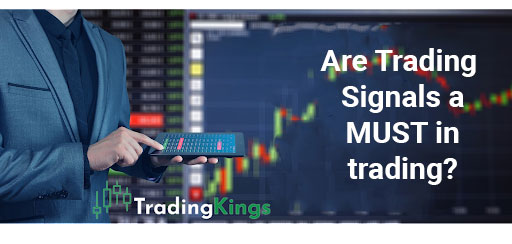Trading is such a fascinating but big world. There are so many terms you need to learn before you start that it can be overwhelming. But here at Trading Kings we have come to the rescue. So we explain each definition in atomic form so you can learn quickly and start trading.
In particular, today we’re going to focus on Trading signals. We will explain everything about them. From what types there are. Even if they are as important as they seem.

What are the Trading Signals and how do they generate?
In simple words; they are defined as probabilities that identify the best and worst times to buy or sell a given asset.
Sounds easy peasy, but we want to go a little further. They’re predictions made by machines or humans based on technical information about the market as well as social behaviour to determine the best time to take action and thus make a profit.
If you get signals from reliable sources, regardless of whether they are predictions made by humans or highly specialised software, you can start making profits in a very short time when trading.
And what do they base the Trading signals on? We told you technical information and social behaviours for short. But in reality, it is largely studied:
- Social events, such as riots, elections, economic problems…
- Natural events, ranging from hurricanes, mudslides, snowfalls, etc.
- Operational history in the stock market of each country. This includes market movement and shares of companies operating in each country.
- Economic events, e.g. Black Friday, Christmas, Mother’s or Father’s Day.
And what does this have to do with anything? This influences how the value of a currency might fluctuate over time and through the signals, you can know when the time is right and when to hold on.
Types of Trading signals
Yet, Trading signals can also be classified into various types. Broadly speaking, these are:
Account management
This is one of the riskiest signals. As the name suggests, a trader makes the decisions on how, when and where to invest your money to generate results. And in return, he or she keeps a fixed percentage or salary.
Account management is also characterised by the fact that the person has no knowledge of changes in the market. Instead, he or she only has knowledge about the results that are obtained.
This type of Trading signal is very common when deciding to put money on fixed terms in special savings or investment accounts. And while they are an option for those who don’t want to get too involved, the truth is that at Trading Kings, we recommend that you are always aware of how and when your money is invested.
Manual trading signals
As you can imagine, these are signals that are predicted through human effort. To do this, the trader must sit for hours and hours behind a computer to research and analyse and thereby come up with an effective prediction.
These types of signals are made by professional traders and are usually based on data provided by trusted brokers and Telegram channels.
This does not mean that if you are just starting out you cannot rely on your knowledge to get the signals. What it does mean is that it will take you longer to get reliable and accurate ones.
Also, you should consider that in addition to the hours of research and analysis, you should take into account some indicators. These are:
- Pattern-breaking signals. Regardless of their form they indicate that something is happening in the market and you should pay attention to fluctuations in values.
- Higher volumes. In trading this translates into new market moves.
- Moving average crossovers. Where different time periods are considered in order to get a better control of the data and a broader picture of the market.
- Volatility signals. One of the most common is the ATR. Although they are also often influenced by social aspects of the country.
- Extreme sentiment. This has nothing to do with sentiment. These are excessive trends in indicators such as RSI or MACD. These can lead to unstable markets where you have to act faster than normal in order to make a profit.
Copy Trading
This is a joint signal. We explain. The signal provider and the trader have connected accounts. For this, the trader pays a subscription. This subscription gives him the benefit that when the provider makes an action, this action is opened automatically or after confirmation by the trader in the trader’s account, redundantly.
In this way, the trader gains some control and detailed information on all transactions made on his account. Although it is an excellent option, you should take into consideration that not all signal providers offer this service, they are not usually as reliable or the cost of subscription is high the first time.
Automatic Trading Signals
These are perhaps the most popular in the market. They are trading software or robots, which are responsible for making the actions when the indicated signals appear.
To do this, the trader must configure which signals to follow and what actions to take when these signals appear. The interesting thing about this type of trading is that it eliminates the stress and hours of research to take action based on a prediction. However, it achieves results in an optimal way and with little margin for error.
The robots are tasked with monitoring the markets 24 hours a day, 7 days a week. However, this does not mean that they operate alone. You have to configure them so that they can carry out the operations and set them according to your preferences.
Also, consider that they are divided into two subtypes:
- Fully automatic trading signals. These are characterized by the fact that they perform trades automatically without prior authorization. They only send you notifications.
- Semi-automatic trading signals. This is the preferred choice for professionals for one simple reason. The robots follow the signals for which they are configured and send notifications when these signals appear. This gives the trader the possibility to have the final word and to decide whether or not to invest at that moment.
Trading alerts
Last but not least, there are the trading alerts. These are the most basic settings you can have. When you open an account with a reputable broker, you can activate notifications to receive certain signals.
AvaTrading and BDSwiss, which are two of the brokers we recommend, have this feature. Although you have to analyze the signals yourself and set them according to your knowledge, you will have the possibility to have full control over your account, your stocks, and your investments.
Trading alerts can be classified into the following types of signals:
- News-based or fundamentals. It is considered that if there are events of any kind in the country (whether political, economic, social or environmental) that may increase the value of a currency, a notification will be sent to you.
- Based on technical analysis. These rely on professional analysis of the trading market to send you signals. This is usually the type of trading alert signals that brokers send you.
Something we almost forgot to mention is the channels through which you will receive trading alerts. It is via SMS, email, Telegram messages and even WhatsApp. There are some who use Twitter to send signals. Hence the importance of subscribing to any broker and agreeing to receive notifications.
Are Trading Signals a MUST in trading?
The short answer is yes. But let’s substantiate our answer. To begin with, Trading signals are one of the best indicators for deciding whether to trade or hold out for the next opportunity.
More than a signal, we could say that it is one more tool in the trading world to make fact-based decisions to invest in the market. However, there are a few tips we would like to give you on how to use them.

Trading signals, as we said at the beginning, are predictions. Therefore, they have a small margin of error and from taking this into account, it is up to you to decide whether to invest based on that signal or not.
Of course, there are signal providers that are super reliable and assertive. But consider that none of them have a 100% or even 90% success rate. And if they offer you that, they’re lying.
Based on that premise there is another detail. If you use robots or automatic trading signals, try to use semi-automatic ones where you are the one who has the final decision on where to invest or not.
On another point, we would like to point out that account management signals sound attractive. Leaving you all the psychological stress of choosing where and when to decide and only seeing results is tempting. However, consider that it has to be a reputable agency or broker. Otherwise, it will cause you more headaches.
And finally, manual trading signals are an option when you already know the market. Why not when you are a newbie? Because it’s a LOT of information that can only make you feel overwhelmed and paralyse you.
